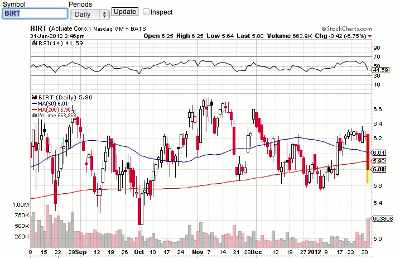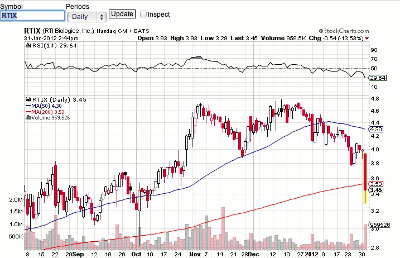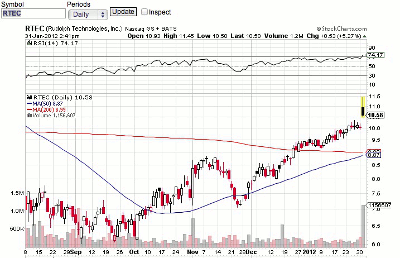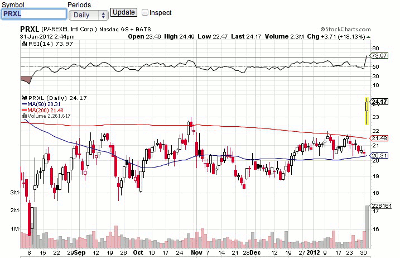Quarterly reports often result in small, thinly traded stocks notching big moves, either up or down. Sometimes it’s not the earnings themselves, but the outlook that’s offered. Kate Stalter reviews the price action of four small companies that reported early this week.
Earnings season can bring changes to major indices when a behemoth like Apple (AAPL) reports. However, there are plenty of smaller companies that are making moves on their own—largely independent of the broader markets—when they report earnings.
One such name making a big jump on Tuesday was enterprise software maker Actuate (BIRT). The company’s products facilitate business reporting and management for corporate customers. The company’s ticker is derived from its software category: Business Intelligence and Reporting Tools.
The San Mateo, California-based company missed revenue views when it reported Monday, and the stock plunged 8.5% intraday in heavier than normal volume, slicing its 200-day moving average.
This is exactly the type of stock that’s susceptible to such plunges. Its market cap is just $292 million, and it moves only 200,000 shares a day. Its beta is 1.21, indicating a high degree of volatility relative to the broader market.
Another post-earnings decliner Tuesday was RTI Biologics (RTIX), maker of tissue-based orthopedic implants. The stock showed good price action through most of 2011, but has tumbled 21.6% so far this month.
It’s working on its seventh week in a row of downside trade. In Tuesday’s session, it plummeted nearly 14% in more than three times normal turnover.
The company beat fourth-quarter earnings views by a penny, coming in with per-share income of four cents. However, what really caught traders’ attention was lower full-year and current-quarter guidance.
This stock, too, illustrates why thinly traded equities with a relatively small market cap require careful handling. Scant institutional ownership means it’s relatively easy for one big shareholder’s actions to make a significant dent in the price.
That effect is magnified when a company issues a disappointing outlook—but clearly, investors had identified problems with the stock in December.
When RTI sliced its 50-day line in heavy volume on January 3, that was a major signal that it was time to exit. With widely held, dividend payers, it’s sometimes less risky for individual investors to hold through corrections. However, a thin, small cap, which exhibits a different trading character altogether, should not be treated the same as a DJIA component.
|pagebreak|One stock that fared better in Tuesday’s trade after its quarterly report was Rudolph Technologies (RTEC). The New Jersey-based company makes gear for the semiconductor industry. It beat on the top and bottom lines when it reported its fourth quarter early Tuesday.
The stock gapped up on Tuesday following the earnings news, but subsequently staged a not-so-bullish reversal lower intraday. This is another extremely volatile stock, with a beta of 1.33. Its market cap is only $356 million, and it moves about 185,000 shares a day.
Part of the reversal may have been related to the same action in the broader market Tuesday, which notched losses after a more promising open. Because Rudolph is a fairly low-priced stock—it was trading around $10.50 mid-session Tuesday—it also likely attracted traders who pocketed some quick gains. That type of activity is less likely to have a big effect on a more widely held, liquid stock.
January marks Rudolph’s fourth month in a row of upside trade, but the stock still has some ground to make up before regaining its 52-week high from May.
Prior to Tuesday, weekly volume has been trending below average for the past few weeks, as the stock has worked its way higher. That’s not ideal action, although it’s also not unusual to see muted trade ahead of earnings.
The stock’s ten-week line just crossed above the longer-term 40-week line, often an indication that further gains could be ahead. It wouldn’t be surprising to see a consolidation in the coming sessions, following Tuesday’s reversal off session highs.
Finally, Paraxel (PRXL), which provides clinical trial services and technologies to the medical industry, vaulted 17.3% after a better-than-expected second quarter report, and was able to keep most of those gains intraday.
This is yet another instance of a small, volatile stock. It’s been forming an erratic consolidation since retreating from April’s 52-week high of $27.91.
Analysts are eyeing 2012 profit growth of 17%, to $1.11 per share. Next year, Wall Street sees earnings of $1.51 a share, a gain of another 30%. That signals good institutional confidence in the stock.
Although Parexel has a way to go before regaining its former high—it was trading near $24 on Tuesday—the fundamental potential makes this one to keep watching.
Also giving the stock a boost Tuesday was a BB&T upgrade to Buy from Hold. The bank’s analyst cited the better-than-expected quarterly results, as well as margin improvement.
At the time of publication, Kate Stalter did not own positions in any of the stocks mentioned in this column.
Related Reading:
























